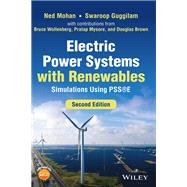Concise, balanced, and fundamentals-based resource providing coverage of power system operation and planning, including simulations using PSS®E software
Electric Power Systems with Renewables provides a comprehensive treatment of various topics related to power systems with an emphasis on renewable energy integration into power systems. The updated use cases and methods in the book build upon the climate change science and renewables currently being integrated with the grid and the ability to manage resilience for electrifying transportation and related power systems as societies identify more ways to move towards a carbon-free future.
Simulation examples and software support are provided by integrating the educational version of PSS®E. The newly revised edition includes new topics on the intelligent use of PSS®E simulation software, presents a short introduction to Python (a widely used software in the power industry), and provides new examples and back-of-the-chapter homework problems to further aid in information retention.
Written by two highly qualified authors with significant experience in the field, Electric Power Systems with Renewables also contains information on:
- Electric energy and the environment, covering hydro power, fossil-fuel based power plants, nuclear power, renewable energy, and distributed generation (DG)
- Power flow in power system networks covers basic power flow equations, the Newton-Raphson procedure, sensitivity analysis, and a new remote bus voltage control concept
- Transformers and generators in power systems, covering basic principles of operation, a simplified model, and per-unit representation
- High voltage DC (HVDC) transmission systems-current-link, and voltage-link systems
Associated with this textbook, there is a website from which the simulation files can be downloaded for use in PSS®E and Python. It also contains short videos to simplify the use of these software. This website will be regularly updated.
Electric Power Systems with Renewables serves as a highly useful textbook for both undergraduate and graduate students in Electrical and Computer Engineering (ECE). It is also an appropriate resource for students outside of ECE who have the prerequisites, such as in mechanical, civil, and chemical engineering. Practicing engineers will greatly benefit with its industry-relevant approach to meet the present-day needs.






